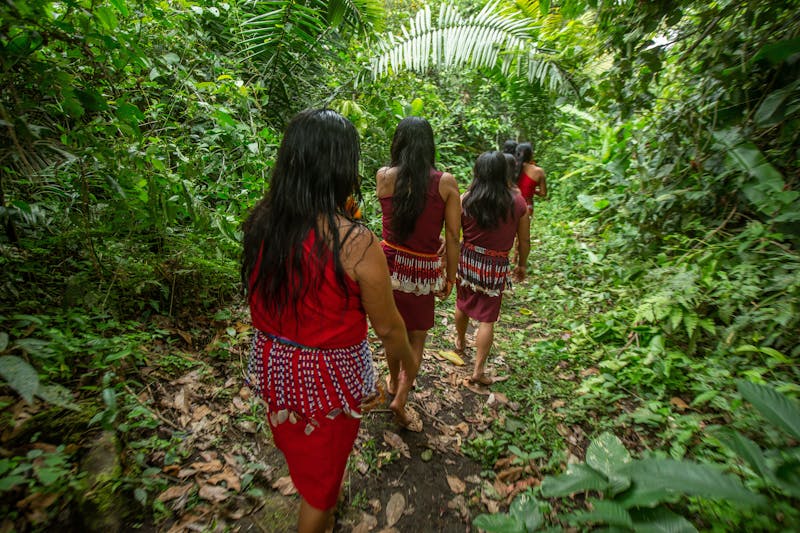Editor’s note: April is Earth Month, when we honor humanity’s shared responsibility for nature and the climate. At Conservation International, this responsibility drives us — and in honor of Earth Month, Conservation News is highlighting stories of our impact. We hope that this inspires you to carry the spirit of Earth Month throughout the year. In honor of this campaign in the coming weeks, Conservation News is spotlighting some recent stories and successes from around the world. We hope you consider supporting our work.
To make conservation work for all, it must be more compassionate, conscious and inclusive. It must also continue to embrace and elevate the voices of Indigenous Peoples and local communities, whose expertise and knowledge of the land and waters they steward is critical to addressing the twin crises of climate change and biodiversity loss. Here are a few recent stories about how Conservation International is reimagining conservation to be more inclusive.
Fashioning a new approach to Indigenous partnerships
Some 370 million Indigenous people are spread around the world, their lands home to a great deal of the raw materials sought by fashion designers — from wool to leather and more. Yet Indigenous communities have typically lacked representation in corporate sustainability, fashion and business.
The result: Indigenous and local knowledge not included in corporate sustainability strategies. Indigenous intellectual property not respected. And the fashion industry’s impact on Indigenous Peoples and nature generally overlooked. “A lot of companies don't actually know where to even begin to engage with Indigenous Peoples,” said Quinn Manson Buchwald, a citizen of the Little Shell Tribe of Chippewa Indians of Montana and the Manitoba Métis Federation, and director of the Indigenous and Traditional Peoples program at Conservation International.
So Buchwald and colleagues at Conservation International — informed by Indigenous people and local communities and in partnership with Textile Exchange, an industry group — set out to establish some fundamentals: How should companies engage with Indigenous communities?
Many of the principles in the guidelines — about consent, collaboration and acknowledging impacts — are intuitive, while others illustrate just how unique some of the gaps are.
Find out more about the principles here.
The fashion industry’s relationship with Indigenous Peoples has historically been fraught — a new initiative aims to reset it.
For these women, sustainable business is buzzing
Bees are nature’s “essential workers” — one-third of the world’s crops rely on pollinators to reproduce.
Around the world, Conservation International is helping bees withstand the effects of pesticides, climate change and shrinking habitats. And we’re doing it by helping women.
Around the world, women beekeepers are helping to protect bees by sharing their knowledge and traditions. The bees, in turn, provide honey — an important source of food and income, which in many cases generates economic independence and autonomy for women in places where there are few other opportunities.
In Colombia, for example, Patricia Rodríguez is benefiting from a Conservation International project that helps Colombia’s highland communities adapt to climate change by promoting sustainable livelihoods. “It’s hard work, but I just fell in love with them,” she says. “The beehives remind me of our women’s group: Every woman plays an important role in our collective success. We’re smart and we work hard, just like bees in a hive.”
Rodríguez uses honey and pollen from her 10 hives to sweeten and fortify the yogurt she makes on her dairy farm. And selling her honey has helped compensate for a drop in milk production amid a recent drought.
Find out more about this program here.
A third of the planet's crops rely on bees and other pollinators to reproduce, yet bees are dying off at alarming rates. Around the world, women beekeepers are fighting to protect nature's "essential workers."
Meet the scientist helping women find their voice
In a community center in rural Madagascar, Kame Westerman noticed something that changed her career: As the men debated the closure of an octopus fishery, the women — who stood to gain or lose the most from the decision — were silent.
“They either weren’t included in the decision-making or didn’t feel comfortable engaging in the discussion,” Westerman recalled of that day a dozen years ago.
“I’d spent years working in community-based conservation,” she said, “but I’d never noticed the gender imbalance in resource management so clearly.”
That realization reshaped her work.
Westerman went on to establish Conservation International’s gender program and has spent more than a decade working with teams in the field to craft practical, culturally sensitive ways to bring women and men equally into conservation.
Find out more here about the challenges women continue to face, and Westerman’s hopes for achieving more inclusive conservation around the world.

During her career, Kame Westerman has seen women's engagement and leadership become a cornerstone of effective conservation.
Bruno Vander Velde is the managing director of storytelling at Conservation International. Want to read more stories like this? Sign up for email updates. Also, please consider supporting our critical work.


